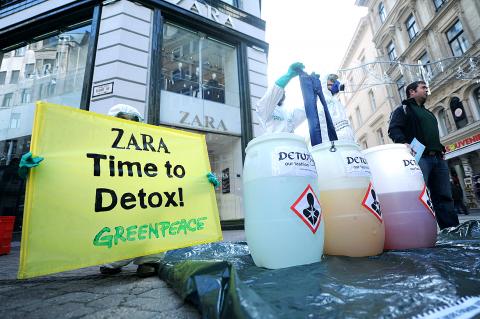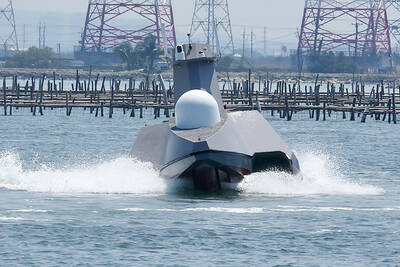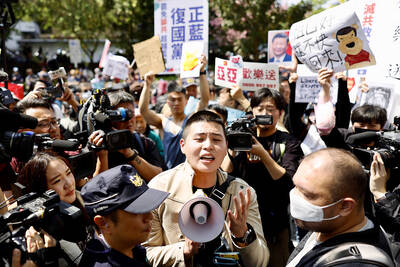An investigation on clothing from 20 global fashion brands showed that 63 percent of the garments contained hazardous nonylphenol ethoxylates (NPE) and a number contained plasticizers or other cancer-causing compounds, Greenpeace said yesterday.
The non-governmental organization made the announcement during the release of its new global investigative report on hazardous chemicals used in the textiles of garments sold at 20 popular global brands, including Armani, Benetton, Calvin Klein, Diesel, Esprit, Gap, H&M, Levi’s, Mango, Tommy Hilfiger and Zara.
Rose Lai (賴倩如), Greenpeace’s pollution prevention campaign director in Taiwan, said a total of 141 garments were purchased from 29 countries and regions around the world in April, including two items bought from stores in Taiwan — a pair of children’s pants by Zara and a men’s T-shirt by Levi’s.

Photo: AFP
The investigation revealed that detectable levels of NPEs were found in 89 of the garments.
“NPEs are often used as detergents or surfactants in the manufacturing process of textiles and can be washed away with water, but NPEs break down into nonylphenols [NP] in the water” Lai said. “NPs are known to be persistent and bio-accumulative toxic substances, which act as hormone disruptors in the body and also accumulate in the tissues of fish and other organisms.”
In addition, the tests discovered detectable levels of plasticizers in 31 garments, including high levels of toxic phthalates in four of the garments, and cancer-causing amines from the use of certain azo dyes in two.
Among the two items bought in Taiwan, a detectable level of NPE was found on the pants by Zara and three types of plasticizer — diethyl phthalate, di-n-butyl phthalate and di(2-ethylhexyl) phthalate — were found on the Levi’s T-shirt.
Although the levels of substances found in the clothes were not considered illegal in Taiwan, Lai said the major brands should bear social responsibility and eliminate the use of these chemicals.
In addition, the companies should “make public information about the use of the chemicals and wastewater discharges containing these substances, and also plan to phase out their use to achieve a goal of zero toxic discharges,” she said.
Lai said Greenpeace’s Detox campaign last year persuaded seven international sportswear brands to commit to finding solutions to cease using the toxic chemical substances in the manufacturing process by 2020, so the organization is also urging fashion brands to take responsibility for the public and the environment.
At present, regulations on the use of these toxic substances are very limited in Taiwan.
The Environmental Protection Administration only prohibits the use of NPE in the manufacture of household detergents and the Toxic Chemical Substances Control Act (毒性化學物質管理法) prohibits four kinds of plasticizers in the manufacture of items for children under 14 years old.
“The government should take a precautionary attitude and pay more attention to toxic pollution and enact stricter regulations for the full-scale management and control of these toxic substances,” Lai said.

ENDEAVOR MANTA: The ship is programmed to automatically return to its designated home port and would self-destruct if seized by another party The Endeavor Manta, Taiwan’s first military-specification uncrewed surface vehicle (USV) tailor-made to operate in the Taiwan Strait in a bid to bolster the nation’s asymmetric combat capabilities made its first appearance at Kaohsiung’s Singda Harbor yesterday. Taking inspiration from Ukraine’s navy, which is using USVs to force Russia’s Black Sea fleet to take shelter within its own ports, CSBC Taiwan (台灣國際造船) established a research and development unit on USVs last year, CSBC chairman Huang Cheng-hung (黃正弘) said. With the exception of the satellite guidance system and the outboard motors — which were purchased from foreign companies that were not affiliated with Chinese-funded

PERMIT REVOKED: The influencer at a news conference said the National Immigration Agency was infringing on human rights and persecuting Chinese spouses Chinese influencer “Yaya in Taiwan” (亞亞在台灣) yesterday evening voluntarily left Taiwan, despite saying yesterday morning that she had “no intention” of leaving after her residence permit was revoked over her comments on Taiwan being “unified” with China by military force. The Ministry of the Interior yesterday had said that it could forcibly deport the influencer at midnight, but was considering taking a more flexible approach and beginning procedures this morning. The influencer, whose given name is Liu Zhenya (劉振亞), departed on a 8:45pm flight from Taipei International Airport (Songshan airport) to Fuzhou, China. Liu held a news conference at the airport at 7pm,

AIR SUPPORT: The Ministry of National Defense thanked the US for the delivery, adding that it was an indicator of the White House’s commitment to the Taiwan Relations Act Deputy Minister of National Defense Po Horng-huei (柏鴻輝) and Representative to the US Alexander Yui on Friday attended a delivery ceremony for the first of Taiwan’s long-awaited 66 F-16C/D Block 70 jets at a Lockheed Martin Corp factory in Greenville, South Carolina. “We are so proud to be the global home of the F-16 and to support Taiwan’s air defense capabilities,” US Representative William Timmons wrote on X, alongside a photograph of Taiwanese and US officials at the event. The F-16C/D Block 70 jets Taiwan ordered have the same capabilities as aircraft that had been upgraded to F-16Vs. The batch of Lockheed Martin

GRIDLOCK: The National Fire Agency’s Special Search and Rescue team is on standby to travel to the countries to help out with the rescue effort A powerful earthquake rocked Myanmar and neighboring Thailand yesterday, killing at least three people in Bangkok and burying dozens when a high-rise building under construction collapsed. Footage shared on social media from Myanmar’s second-largest city showed widespread destruction, raising fears that many were trapped under the rubble or killed. The magnitude 7.7 earthquake, with an epicenter near Mandalay in Myanmar, struck at midday and was followed by a strong magnitude 6.4 aftershock. The extent of death, injury and destruction — especially in Myanmar, which is embroiled in a civil war and where information is tightly controlled at the best of times —